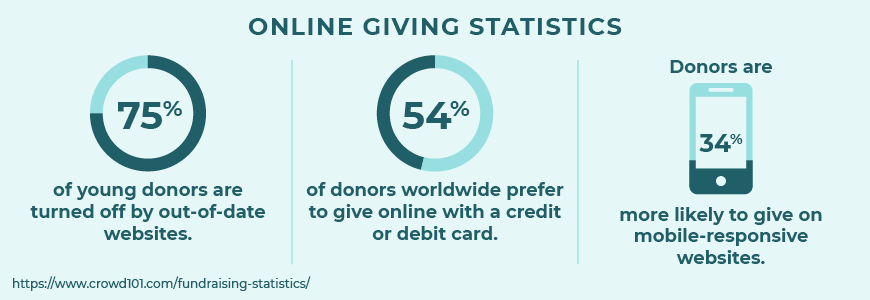In 2024, churches are facing new challenges when it comes to raising funds. Traditional methods, like passing the offering plate or hosting bake sales, may not be enough to meet the growing needs of modern congregations.
As the world becomes more digital and connected, churches need to find fresh, innovative ways to encourage giving and support their missions. This guide will explore the best fundraising strategies for 2024, focusing on technology, community involvement, and creative approaches that can help churches reach their financial goals.
Whether you’re looking to grow your church’s ministry, fund a new building project, or support outreach programs, these ideas will inspire you to think outside the box and engage your congregation in new and exciting ways. By embracing these strategies, your church can thrive and continue making a positive impact in your community and beyond.
Ready to learn more? Let’s jump in.
Estimated reading time: 11 minutes
Table of contents
Church Fundraising

Before we get into our top 6 innovative fundraising ideas for churches in the modern day, let’s explore everything you need to know about fundraising. We’ll do a brief overview, explain how fundraising has evolved over time, and go over the challenges churches face in fundraising today.
Overview of Church Fundraising
Church fundraising is an essential part of supporting the church’s mission and activities. Churches often rely on donations from church members to cover expenses like building maintenance, staff salaries, and outreach programs. A church fundraiser can take many forms, from special events to simple offerings during services.
These efforts help raise money for specific needs, such as a mission trip, a youth group camp, or a new church building project. Raising funds helps keep the church running smoothly and allows it to grow its impact within the community.
Fundraising: An Evolution
In the past, raising money for the church was often done through traditional methods like passing the offering plate during Sunday service, holding bake sales, or organizing large church fundraiser events like dinners or concerts. While these methods are still used today, fundraising has evolved with technology.
Now, churches can raise funds online through digital giving platforms, host virtual events, and use social media to engage more people in their fundraising efforts. This shift allows churches to reach a larger audience and makes it easier for church members and others to donate.
Challenges of Fundraising in 2024
Fundraising in 2024 brings new challenges for churches. As people become more connected online, they expect easier, more convenient ways to raise money. At the same time, many church members are dealing with financial pressures, which can make it harder for them to give.
Another challenge is keeping up with changing technology, like cryptocurrency donations or digital fundraising tools. Churches also need to find creative ways to engage younger generations, who may not always be familiar with traditional church fundraiser methods.
Additionally, churches must stay connected to their mission while being transparent about how they raise funds and use donations. Despite these challenges, churches can still be successful in raising money by adapting to new methods and focusing on building strong relationships with their church members and supporters.
By understanding these challenges and adjusting their strategies, churches can continue to fund important projects while staying connected with their communities.
6 Innovative Church Fundraising Ideas

And that’s everything you need to know about church fundraising today. Some things are easier than ever before, and some things are even harder! It’s important that we are flexible and adjust our strategies as the world around us changes.
In this section, we’ll cover our 6 favorite church fundraising ideas. These are all innovative church fundraiser ideas that take advantage of the tools we have at our disposal in 2024.
Let’s dive in.
1. Digital Giving Platforms
Our first church fundraising idea is to focus on digital giving platforms as a way to receive money for your fundraisers. These have become a popular way for churches to raise money in 2024. They allow church members to donate online quickly and easily, without the need for cash or checks. With these tools, people can give from their smartphones, computers, or even set up automatic donations, making it more convenient to support the church regularly.
According to Crowd101, 54% of people prefer to give online than in-person.

If your church doesn’t yet provide members a quick and easy way to give online, you are missing out!
Using digital giving platforms can help your church reach a wider audience. Not only can current members donate, but people from other places who support the church’s mission can give as well. These platforms also make it easier for churches to track donations, ensuring that funds are managed responsibly.
Some common digital giving platforms include Tithe.ly, SecureGive, and Pushpay. For a full review of all of your options, check out our review of the top 7 best online giving solutions for churches.
Your church should be using online giving platforms for all your tithes and offerings. But you can use them to fundraise too! This method is especially helpful for younger generations, who are used to doing everything online.
By embracing digital giving, churches can make raising money simpler, more efficient, and more accessible for everyone. It’s a great way to keep up with the times and make it easy for church members to give whenever they feel called to support their church.
2. Crowdfunding/Peer-to-Peer Fundraising
Crowdfunding and peer-to-peer fundraising are two innovative ways for churches to raise money in 2024. Crowdfunding involves setting up an online campaign where community members can donate to a specific cause, like a mission trip, building project, or outreach program. Platforms like GoFundMe or Kickstarter are popular for these types of efforts.
The church shares the campaign link with its members and the community, and people can donate directly online. Crowdfunding is a great way to reach a large number of people quickly.
Peer-to-peer fundraising takes this a step further by allowing community members to create their own fundraising pages to support the church’s campaign. They can then share their personal page with their family and friends to help raise even more money. This strategy works well because it expands the church’s reach beyond its regular attendees.
Benefits of crowdfunding and peer-to-peer fundraising include:
- Wider Reach: Church and community members can share the campaign online, bringing in donations from people everywhere.
- Personalized Giving: Peer-to-peer fundraising allows members to feel more connected to the cause.
- Transparency: Donors can see the progress of the campaign and how their contributions help.
These methods are effective, especially for specific projects, and engage the broader community.
3. Subscription/Membership Models
Subscription and membership models are a growing way for churches to raise funds regularly. With this method, church members and supporters can sign up to give a set amount of money each month. This creates a steady stream of income for the church, which helps with planning and budgeting for ongoing expenses like utilities, staff salaries, and outreach programs.
One of the key benefits of subscription models is the convenience it offers to both the church and its members. Donors don’t have to remember to give each week, and the church can count on consistent support. Some churches offer special benefits to those who sign up for these recurring donations, such as exclusive content, early access to events, or special recognition.
Membership models can also be used to create different levels of giving. For example, a church might offer different tiers, where higher levels of support come with additional perks. This can help churches meet their financial goals while offering a meaningful way for church members to feel connected to the church’s mission.
Overall, subscription and membership models are a simple and effective way for churches to raise money consistently, providing both stability and growth opportunities for their ministries.
4. Cause-Based Fundraising

Cause-based fundraising focuses on raising money for specific causes that resonate with the church community. Instead of general donations, this type of church fundraising event is built around a clear, meaningful cause, such as helping those affected by natural disasters, supporting a mission trip, or funding a local outreach program.
This method works well because people are often more inspired to give when they understand exactly where their money is going. By tying fundraising to a cause, churches can make their members feel more connected to the effort and more motivated to support it. For example, a church fundraising event could be held to raise money for building a new shelter for the homeless or sponsoring a water project in a developing country.
As a bonus idea, get your media team involved to spread the word! Create shareable social media posts and videos that highlight the cause you are focusing on. This way, you can use social media channels for a positive impact and get your church members involved in spreading the word.
Churches can also use cause-based fundraising to appeal to a broader audience beyond the regular congregation. The church community can share the event or campaign with their friends, neighbors, or even through social media, encouraging more people to get involved.
5. Community-Focused Fundraising
Community-focused fundraising is all about engaging the local community to support the church’s mission and projects. This type of fundraising brings local businesses, church members, and neighbors together to raise money for a cause that benefits everyone. Churches can organize events like charity dinners, car washes, or fairs that invite the community to participate, creating a sense of unity and purpose.
Partnering with local businesses is a key part of community-focused fundraising. Many businesses are eager to support local causes, and they can provide sponsorships, donate goods or services, or help promote the event. In return, the church offers businesses the chance to connect with new customers and show their commitment to the community.
Here are some reasons why community-focused fundraising works:
- Brings People Together: Events create a fun, welcoming environment where people feel encouraged to participate and give.
- Boosts Local Support: Involving local businesses helps spread the word and attract more people to the cause.
- Builds Relationships: Working closely with the community strengthens ties and opens up future opportunities for collaboration.
By focusing on the community, churches can raise funds while building stronger relationships with their neighbors and local businesses, creating a positive, lasting impact.
6. Engaging Younger Generations
Engaging younger generations in church fundraisers is essential for future support. Young people, such as Millennials and Gen Z, often connect with causes in different ways compared to older generations. To capture their interest, churches can use social media platforms like Instagram and TikTok, where many young people spend their time. By creating interactive and shareable content, churches can make fundraising more appealing.
Another effective method is gamification. Incorporating fun elements like challenges or rewards can make church fundraisers more engaging. For example, setting up a competition or offering small prizes for fundraising achievements can motivate younger people to participate and contribute.
By adapting fundraising strategies to fit the interests and habits of younger generations, churches can build a more dynamic and involved community, ensuring long-term support and a vibrant future for their activities and missions.
Church Fundraising in 2024

In conclusion, adapting fundraising strategies to meet the needs of 2024 is key for churches to thrive. Embracing digital tools, innovative approaches like crowdfunding, and engaging with the younger generation can help churches achieve their financial goals and strengthen their community connections.
By focusing on clear causes, collaborating with local businesses, and using modern methods, churches can raise funds effectively while building lasting relationships. With these strategies, churches can continue to support their missions and make a positive impact, ensuring they remain vibrant and relevant in an ever-changing world.
Let us know in the comments below if there are any other fundraising strategies you can think of! We hope these were helpful for you and your church. God bless!
More Resources on Fundraising





